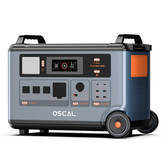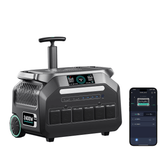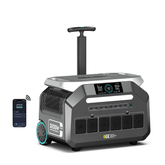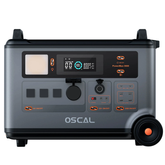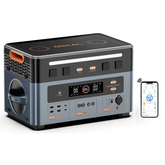Best Budget Portable Power Station: A Practical Guide for EU Buyers
Finding the best budget portable power station has become a priority for many EU buyers. Whether you need a compact unit for weekend camping or a larger battery for home backup, a budget-friendly portable power station can provide quiet, emissions-free power without the complexity of a fuel generator. This guide helps you choose the right model for your needs, explains the key specifications to watch for, and suggests practical ways to use and maintain your unit in the European context.
Why Europeans Are Choosing Portable Power Stations
Across Europe, portable power stations are increasingly popular for several clear reasons:
- Reliable home backup — storms and grid interruptions happen, and a portable station keeps phones, routers and essential medical equipment running.
- Outdoor freedom — campers, caravanners and day-trippers want quiet, clean power for fridges, lights and chargers.
- Solar compatibility — many units pair with foldable solar panels for off-grid charging.
- Cleaner and simpler than petrol generators — no fumes, no maintenance, and safe to use indoors.
What “Best Budget Portable Power Station” Actually Means
“Budget” doesn’t mean you accept poor safety or extremely short life. The best budget portable power station balances price with solid core features. Look for:
- Safe battery chemistry — LiFePO4 is preferred for longevity and thermal stability; NCM is common but usually has a shorter cycle life.
- Clear wattage and capacity specs — the inverter rating (W) and battery capacity (Wh) determine what you can run and for how long.
- Solar input and MPPT — improves real-world solar charging efficiency.
- EU compatibility — 230V / 50Hz AC outputs and Schuko plugs or appropriate adapters.
- Reasonable warranty and EU support — local returns and service matter more than headline price.
Key Technical Terms — Explained Simply
- Watt-hours (Wh) — battery energy. Example: a 500Wh battery can deliver 100W for 5 hours.
- Continuous output (W) — how much power the inverter can provide steadily.
- Surge (peak) power — short bursts to start motors or compressors.
- MPPT — a solar charge controller type that yields faster and more efficient solar charging.
- LiFePO4 vs NCM — LiFePO4 wins on safety and cycle life; NCM can be lighter and cheaper but ages faster.
How to Choose the Right Model: A Practical Process

Follow this simple five-step process to identify the best budget portable power station for your use:
Step 1 — Calculate Your Power Needs
List devices you want to run, then multiply wattage by hours to get Wh. Example:
- Router + phone charging: 30W × 6 hours = 180Wh
- Small fridge: 70W × 8 hours = 560Wh
Add a margin of 20–30% for inefficiencies and startup surges.
Step 2 — Pick the Battery Size
Match Wh to your needs:
- 300–500Wh — great for weekend trips and phone/laptop charging.
- 600–1000Wh — good for extended camping or running a fridge for many hours.
- 1000Wh+ — suitable for light home backup and longer off-grid stays.
Step 3 — Check the Inverter Rating
Ensure the continuous and surge ratings cover the appliances you expect to run (fridge motors, pumps and power tools need higher surge support).
Step 4 — Evaluate Charging Options
For EU users, look for:
- Fast AC charging (1–2 hours is excellent for a budget unit).
- Solar charging with MPPT (for realistic off-grid use).
- Car charging if you plan long road trips.
Step 5 — Think About Portability
Weight matters: a 5–8 kg unit is easy to carry; 12–20 kg units are better for stationary backup. Consider handles or wheeled options for heavier models.
Top Features to Prioritise in Budget Models
- Pure sine wave inverter — protects sensitive electronics.
- USB-C PD ports — very useful for modern laptops and fast charging.
- Multiple AC sockets — avoid models with only one outlet if you want versatility.
- Clear LCD or app — easy monitoring improves usability.
- Good thermal management — prevents throttling and extends battery life.
Typical Use Cases for Budget Portable Power Stations
- Home emergency backup — keep lights, routers and essential medical devices running.
- Camping and caravanning — charge cameras, speakers, small fridges and lights.
- Remote work — reliable laptop power for digital nomads and students.
- Fieldwork — photographers, technicians and market traders can run small equipment away from mains.
Practical Examples — What Different Sizes Can Run
| Battery (Wh) | Typical Run | Good For |
|---|---|---|
| 300–500Wh | Phones, laptops, LED lights for a day | Weekend camping, short outages |
| 600–1000Wh | Mini fridge for several hours, small appliances | Extended trips, temporary home backup |
| 1000Wh+ | Longer fridge runtime, CPAP, power tools | Serious backup or multi-device camping |
Solar Panels and Real-World Charging
Pairing a power station with a foldable solar panel is a popular choice in sunny parts of Europe. Keep in mind:
- MPPT charge controllers give noticeably higher solar yield than PWM alternatives.
- Solar input limits (e.g. 200W, 500W) dictate how fast the battery can recharge from panels.
- Real solar yield depends on season and latitude — southern Europe will produce far more than northern regions in winter.
Maintenance and Battery Care
To get the longest life from your budget portable power station:
- Store at 40–60% charge if you won’t use it for months.
- Avoid deep discharges whenever possible.
- Keep firmware up to date (some units support OTA updates).
- Clean solar panels and keep them angled for maximum sun exposure.
How to Compare Budget Models — Quick Checklist
- Battery chemistry (LiFePO4 preferred).
- Rated Wh and usable Wh (some brands overstate usable energy).
- Continuous and surge inverter ratings.
- Solar input type and MPPT presence.
- Number and type of outputs (AC, USB-C PD, USB-A, 12V).
- Warranty length and EU support.
- Real user reviews: prefer verified buyers and long-term tests.
Common Pitfalls to Avoid
- Choosing a model only by headline Wh—check usable Wh and inverter efficiency.
- Ignoring surge ratings when you intend to run motorised appliances.
- Assuming all USB-C PD ports deliver laptop charging—check wattage per port.
- Buying from sellers without EU returns or warranty support.
Budget vs Premium — When to Spend More
If you plan to power refrigerators, medical devices, or heavy tools regularly, a higher-capacity unit or a premium model with LiFePO4 and rigorous safety certifications is worth the extra cost. For occasional camping and light backup, a well-chosen budget model will deliver great value.
Where to Buy Safely in the EU
Prefer vendors with EU warehouses, local returns and clear warranty terms. Check for:
- EU stock location and shipping times.
- Clear contact information and local support options.
- Verified user reviews from EU customers.
Final Recommendations
Choosing the best budget portable power station means balancing capacity, inverter strength, safety and practical features like solar compatibility and EU plug support. For most EU users:
- Pick a unit with at least 300–500Wh if your needs are light.
- Choose 600–1000Wh for longer trips or small home backup.
- Prefer LiFePO4 where possible for longer life and safety.
- Verify solar input and MPPT support if you intend to recharge from panels.
- Buy from sellers with EU warranty and returns to avoid headaches.
With the right model, a budget portable power station can offer years of reliable service—protecting your home during outages and making outdoor life easier and greener.

